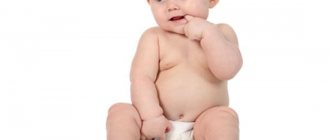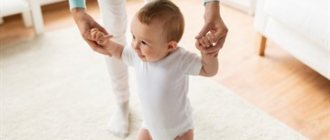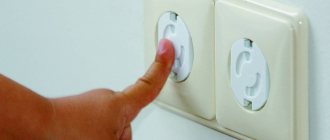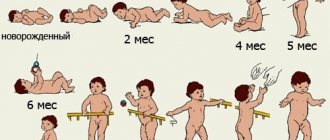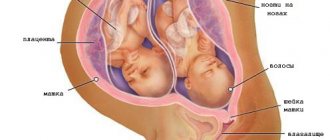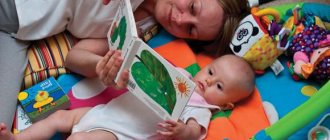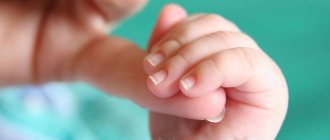Physiology and physical development
A six-month-old baby is quite physically developed. The baby’s muscle corset and skeleton are already developed enough for your baby to be able to try to sit up on his own, stand up while holding onto a support, and crawl. Children can roll over well from their back to their stomach, lift their torso, leaning on their hands, and can stay in this position for quite a long time.
The baby reaches for a toy if it is placed in front of him at arm's length. However, not all children are developed equally. Some may not be able to sit, stand or crawl on their own during this time. No need to worry about this. This means that the muscle corset is not sufficiently formed, and the baby is not yet ready for such actions - it is worth paying attention to gymnastics and massage to strengthen the child’s muscles.
His vision is now so developed that he can easily follow people and moving objects. Children of this age are starting to teethe. In this regard, the baby may have increased salivation.
During the sixth month of life, babies gain about 600-700 grams and grow by 1.5-2 cm. A girl is 6 months old. can weigh 6.5-8 kg, and a boy - 7-9 kg. These are averages. A child may weigh more or less, depending on the characteristics of his heredity, nutrition, activity and other things. Height on average is 65-69 cm.
Average weight, height, head and chest circumferences are presented in Table 1. Head circumference increases slightly less than chest circumference. The ratio of these indicators is gradually approaching that of adults.
| Age | Average body weight, g | Height, cm | Head circumference, cm | Chest circumference, cm |
| newborn | 3100-3800 | 50-54 | 34-35 | 32-34 |
| 1 month | 3700-4400 | 53-57 | 35-36 | 35-36 |
| 3 months | 5200-6200 | 58-63 | 40-41 | 39-40 |
| 6 months | 7100-8000 | 66-70 | 43-44 | 44-45 |
| 12 months | 10000-11500 | 74-80 | 46-47 | 48-49 |
Is there any reason to worry?
To make sure that everything is fine with the baby’s development, parents need to know what a healthy child must be able to do at six months:
- first of all, the baby must turn its head;
- The baby’s ability to roll over from back to stomach and back is considered necessary;
- the baby must be able to sit, at least with the support of an adult;
- It is absolutely normal for a child to explore objects by putting them in his mouth;
- A child’s speech at six months can be a hum; this is important, since after that syllables will definitely begin to slip through.
In general, healthy children are tireless explorers who show interest in everything that catches their eye. Therefore, a child’s lack of interest in the people and objects around him should be alarming.
What can a child do?
The basic skills of a six-month-old baby are approximately the following:
- A child at 6 months turns over from back to tummy and back;
- Stands on his feet, supported by support or with the support of an adult;
- Can sit independently, without support, and some children sit up on their own;
- Some babies can crawl on all fours or on their bellies, most crawl on all fours;
- The baby must be able to control his hands, take a toy, transfer it from hand to hand;
- May play with toys independently or with a parent for some time;
- Can pick up a toy and throw it;
- Loves to study objects, touches and puts things in his mouth;
- A 6-month-old child already knows the names of many objects. If you pronounce the name, it searches for an object with its eyes;
- Recognizes his name, responds to calls with a smile or movements;
- Pronounces many different sounds, and even syllables;
- Distinguishes between friends and strangers. He is wary of strangers, but loves other children.
- Can remove food from a spoon with its lips.
What games and exercises with the baby are useful at this stage?
The baby wants to receive new tactile experiences. Let him touch different surfaces: warm and cold, soft and hard, smooth and rough. These can be not only toys, but also household items: spoons, cups, terry towels, silk robes. Tell him about the sensations he experiences.
Take a piece of ice from the refrigerator and touch its handle or cheek. Observe how the child reacts. Bring it to the fan. Give a warm blast of air and then turn off the fan. After a few seconds, repeat all over again.
Instead of a fan, create a breeze using a sheet of paper or a handkerchief. Wave it in front of the baby's face so that a stream of air hits it.
Fill several fabric bags with different cereals and tie them tightly so that the cereal does not accidentally spill. Make the bags of different sizes, but such that the child can hold them. Place them with other toys and your baby will explore them too. Instead of bags, you can use any scraps of fabric that you have around the house. Fill them just like the bags with cereal and tie them with a knot.
Care
There are no special changes in hygiene care. We wash the child in the morning, trim his nails, clean his ears and nose. If teeth appear, then we add cleaning of the oral cavity using a special silicone toothbrush, which the mother can put on her finger.
A baby at this age usually loves to swim. He can sit in the bath by himself and loves to play with toys in the water. However, you should not leave your child unattended. In skin care, special foams and shampoos are used according to age, but not every day. If a little explorer spends a lot of time on the floor, then you need to wash his hands more often.
Let's talk about toys.
At this age, the child still needs quite simple toys. The basic requirements for them are the same: toys should not pose a danger to the child’s health - toys with sharp edges should not be given, toys that can be disassembled into small parts should not be given. Toys should be made of material that is easy to wash: rubber, wood, plastic.
Choose toys for your child that are bright, colorful, colorful, and of various shapes. Remember that a toy is not just abstract fun, but an object that develops a child; the toy develops color perception, spatial imagination (shape relationships); by playing with a toy, the child learns to coordinate his movements and perceive an object visually from different distances; he tries it by touch - a hard toy or a soft one; and even tastes it.
Of course, buy toys for your child according to his age. But if you come across something more complex in the store and can’t resist, buy this toy too. The child will grow up, and she will come in handy. But if you bought such a toy, do not show it to your child prematurely - so that he does not get used to it and subsequently lose interest in this toy.
The child's interest in the toy is important. Change the toys your child plays with from time to time. If you notice that your baby has become indifferent to a certain toy, hide it in the closet for a week and buy another toy. When you take out the old toy after a week, you will be convinced that the child will again play with it with pleasure - and will perceive it as you perceive an old acquaintance.
Play with toys with your child too. After all, only from you can he find out what kind of toys these are: that a dog is a dog, and a cat with a bow is a cat with a bow; The dog barks, the cat meows. All this is incredibly interesting for the baby. In these first games he is presented with a simple model of the world.
You need to know that playing with your child establishes closer emotional contact between you. Such contacts are one of the foundations of your subsequent relationship with your child. In particular - respect, love... You want your child to treat you with the most tender love for many years... Do more work with him. Let him discover the world at your suggestion, let him see his surroundings through your eyes.
When giving your child different toys (preferably one at a time), name them. The child, even if he is not yet able to speak, remembers words and their meaning. Over time, this will help him speak faster.
If you give your child collapsible toys, then choose ones that do not pose a danger to the child: for example, collapsible nesting dolls, cubes, pyramids. The parts of disassembled toys should not be too small. Young children at this age understand not only the world around them, but also their own body. And it can be very interesting for a child to stick a fragment of a mosaic into his nose or hide a button that came off a doll’s dress in his ear, etc.
Daily regime
The daily routine at this age does not change significantly. The time spent awake increases and the time spent sleeping decreases. Now the baby sleeps up to 15 hours a day. Daytime sleep occurs 2-3 times for one and a half to two hours. While the child is awake, it is necessary to engage in educational games, gymnastics, hygiene procedures and speech development.
You can leave your baby to play alone for a while. During walks, a child of this age is more interested in the world around him. Therefore, while walking you can not only sleep, but also get acquainted with nature, animals and other things. Swimming before bed, gymnastics, massage, and hardening are still relevant.
Sleep Features
After six months, children usually sleep from 12 to 14 hours a day. Two daytime naps of 60-90 minutes and a night nap - from 5 to 7 hours. Infants who are accustomed to latching on to their mother's breast several times a night still ask for milk at night. This is a normal phenomenon, each child’s regime is individual. To increase the number of hours of sleep at night, you need to follow these recommendations:
- Long interval between daytime and night sleep (from 5 hours).
- Hygiene procedures, caring for a newborn and bathing the baby in the evening before going to bed. Komarovsky recommends heating the water to 34 degrees so that the baby can actively move while taking a bath and expend the maximum amount of energy. After such procedures, children usually sleep soundly.
- Mandatory feeding after bathing. If the baby is hungry, he will not be able to sleep for several hours without waking up, which will cause significant discomfort to his mother, who will not be able to get a good night's sleep, so you need to breastfeed the baby or pour formula into a bottle so that he eats a hearty meal before closing his eyes.
Nutrition
Breast milk remains the main diet for a six-month-old baby, but at 6 months it is recommended that the first complementary foods be introduced into the child’s diet. Most often, this complementary food is baby kefir or vegetable puree, but if the baby is not gaining weight well, the first complementary food is porridge.
Complementary foods are introduced gradually, starting with very small doses. If the child tolerates the product normally, then the dose is gradually increased. Over the course of a week, a teaspoon is increased to a full serving and replaces one feeding. After a week, you can start introducing the next product.
In bottle-fed children, the introduction of complementary foods begins earlier. Usually by six months the menu of such children is more varied. It includes cereals, vegetables, fermented milk products, juices, but an adapted milk formula is still necessary, it is the basis of nutrition.
Learn more about nutrition in this video:
Medical observation at 6 months
The six-month-old baby continues to be monitored by a pediatrician. Parents are advised to adhere to the schedule of monitoring visits.
Every six months you need to visit and undergo an examination with:
- orthopedist;
- ophthalmologist;
- neurologist;
- surgeon
In case of illness, you must consult a doctor immediately. The pediatrician will make a diagnosis and prescribe treatment for the baby.
Babbling and the need to communicate
By six months, children already have about 40 sounds in their reserve. The baby pronounces them separately, in syllables, in “his own words.” This kind of “speech” is called babbling. If you leave a child alone in a crib with toys, he can babble for quite a long time, playing on his own, but when he gets tired, he will call his mother, of course, for now only in his own language. The development of speech is becoming more and more noticeable and very soon your treasure will delight you with its first words.
At this age, babies are afraid of strangers; if they speak, they can hide behind their mother, or even cry. But they love to communicate with acquaintances, especially close ones. Therefore, at this age, it is imperative to talk to the baby as much as possible, read to him, talk about everything around him, this will have a beneficial effect on his further development.
How to encourage your baby to “talk”?
When the baby pronounces not only individual sounds, but also some sound combinations: “ygi”, “ghy”, “uh-huh” and others, listen to them and repeat after him. When the child pronounces the next sounds, repeat them again after him. Soon you will be able to play the “conversation” game one at a time. Always talk to your baby when you hold him in your arms, when you feed him, when you dress him, when you put him to bed.
Talk about what you do. Speak to the little ones in short phrases and simple words, repeat the words. Sing vowel sounds and chains of repeated syllables (ge-ge-ge, dey-dey-dey, ma-ma-ma, ba-ba-ba). Make sounds by puffing out your cheeks and rounding your lips.
Don’t forget to change your intonation, make it expressive and bright. Leave pauses in your speech, then the baby will have time to say something. Play conversation with your baby until he gets tired and bored. If he stops taking turns, stop this activity and give your baby toys.
Toys and items useful for the development of children of this age:
- mobile,
- rubber teether ring,
- musical toys (rattles, drum, xylophone, pipes, bells),
- a ball with a bell inside,
- big ball,
- mirror and toys with mirror surfaces,
- tube-tubes with cereal and shiny fillers that spill when shaken,
- toys for visual tracking (with transparent walls, allowing you to watch the falling balls),
- a disk divided into colored sectors (by looking at a contrasting pattern, the baby develops visual perception),
- soft book with pictures.
Daily regime
The baby's approximate daily routine now looks something like this:
- 7.00 – wake up, first feeding
- 8.00 – hygiene care.
- 9.00 – first nap of the day.
- 11.00 – second feeding, wakefulness, games, activities with the baby.
- 13.00 – second nap. It is good to combine it with a walk in the fresh air.
- 14.00 – rise, feeding.
- 14.30 – games with the baby, walk.
- 15.30 – third nap, better outside.
- 17.00 – return home feeding.
- 17.30 – wakefulness
- 20.00 – bathing the baby, feeding.
- 21.00 – going to bed.
Usually, breastfed babies wake up to eat, but bottle-fed babies sleep until the morning.
In order to promptly replace developmental disorders, you need to carefully monitor your baby. We recommend that you familiarize yourself with the material on what a child should be able to do at 3 months.
Height and weight of a 6-month-old child, data from domestic pediatricians
| 6 months | Bottom line | Upper limit |
| Boys' weight, kg | 6,6 | 9,0 |
| Girls' weight, kg | 6,3 | 8,3 |
| Boys' height, cm | 63,0 | 69,0 |
| Girls' height, cm | 62,5 | 68,8 |
| Boys' head circumference, cm | 42,0 | 45,5 |
| Head circumference of girls, cm | 41,5 | 44,2 |
| Boys chest circumference, cm | 41,4 | 47,6 |
| Girls chest circumference, cm | 41,6 | 45,8 |
Educational games and activities
The baby's development can be stimulated by engaging with him and playing educational games. At this age, in addition to rattles, children are interested in large colored cubes, preferably soft ones, pyramids, and musical toys. A six-month-old baby will also need teethers.
A child can be captivated by books with bright illustrations; please note - it is better to take special books made of thick cardboard so that the reader himself can open and close them. The baby will enjoy looking at animals and objects, and at this time the mother will pronounce the names of the pictures, so the baby will begin to remember them.
Children at 6 months love to listen to music, fairy tales, and nursery rhymes. The baby will also really like finger games: “Magpie-Crow”, “Boy-Finger”, “Horned Goat” and others. You can still play hide and seek, okay.
Physical exercises, gymnastics, exercises on a phytoball, swimming (you can do such activities in the bathroom) will help your baby’s development. Exercises on the ball will help strengthen all the child’s muscles:
- The rocking exercise strengthens the muscles of the back and neck.
Place the baby on the phytoball, holding him by the legs. Rock the ball back and forth.
- Place the baby on the phytoball on his tummy.
Swing the ball left and right, back and forth, holding the baby by the back.
- Place your baby on the ball, supporting his armpits.
Let him spring with his legs a little, then move his feet, pushing the ball. Lower your baby to the floor often so that he can crawl. Crawling helps strengthen the leg muscles and back.
You can watch other educational games in the following video:
Basic Skills
What a six month old baby should be able to do:
- Confidently distinguish mom and dad, relatives from strangers;
- React to familiar sounds;
- Try to crawl;
- Roll from back to tummy or side, and back;
- Try to learn to sit steadily;
- Must sit down when pulled by the handles;
- Be interested in unfamiliar objects, sounds, new toys;
- Enjoy your parents and well-known people;
- Take objects of interest to him with two hands, throw them, put them in his mouth;
- Pay attention to the object you named that is familiar to him;
- Eat complementary foods.
Physical development
Weight gain and height slow down. On average, at 6 months, children grow 1-2 centimeters and gain 500-650 grams. According to established standards, the parameters of a six-month-old child are:
- Weight: 6.1–9.4 kilograms.
- Height: 61.7–71.2 centimeters.
- Head circumference: 43.2–44.2 centimeters.
- Chest circumference: 44.3–45.5 centimeters.
If there are slight deviations, they are not scary, since each development is individual.
We sit down correctly
From 6 months, children begin to sit up, crawl, and in some cases stand or even walk with support. If this does not happen, there is no cause for concern. All children are different, if a child does not have neurological diseases or diseases of the musculoskeletal system, he will sit down at the right time without any problems. Your main task is not to help, refuse walkers and sitting swings. Don't cover your baby with pillows like our grandmothers did.
Encourage crawling: place your favorite toy or bright ball on the floor three meters from your baby and let him try to get there. The later the vertical load on the spine occurs, the more even the back and stronger the legs of your little one will be.
Take your child out of the crib and put him on the floor more often, this contributes to more intensive development and knowledge of the world around him.
A six-month-old baby's teeth begin to appear; as a rule, the lower central incisor erupts first.
Emotional development
At 6 months, the baby’s hearing sharpens, visual perception and coordination of movements improve. He focuses on individual events: if he cries, then an interesting thing can quickly distract him. When turning a toy, rearranging objects, or leafing through a book, he uses two hands instead of one. An important stage of development at 6 months is coordination of movements, when the child takes his foot with his hand and puts it in his mouth. This is a very difficult action, since he must coordinate his mouth, his arms, and his legs, but a six-month-old baby must perform it.
The child’s speech is developing, read books to him more often, tell him nursery rhymes, accompanying his movements, play “peek-a-boo.”
When your child sits down, surround him with useful toys that develop fine motor skills. These can be pyramids, figures of different sizes that are nested inside each other, soft toys made from different materials and stuffed with peas, cherry pits, beans or sand.
Do not give objects that are too small; at 6 months, children taste everything; make sure that the baby does not swallow or choke.
Your baby absorbs everything like a sponge, try to voice all your actions, call toys and things by their proper names. If you call your child's name often, he may respond to it.
Sleep should be about 14 hours a day: once at night, lasting 7-9 hours, and 2-4 times during the day. Some children refuse night feeding at this age.
Up to 6 months, children cry because of discomfort, then their stomach hurts, then they want to eat, after this milestone the child is emotionally receptive, if you swear, talk in a raised voice, everything is transferred to him with lightning speed. Try to create a calm atmosphere. The baby begins to study strangers, after which he may smile or be capricious.
Common problems
At six months of age, the following problems may most often arise:
- Pain and anxiety from teething.
In this case, the child’s gums become inflamed and itchy, his health worsens, and moodiness appears. The temperature may rise and loose stools may appear. To alleviate the condition, you can use teethers and special gels with anesthetic.
- If DPT vaccination goes according to plan, then at this age the baby needs to get a third vaccination.
After it, negative reactions appear especially often. Mom should be prepared in advance for a possible increase in temperature and other problems.
- Poor night's sleep.
With this problem, following a daily routine will help, long walks; between night sleep and the last daytime sleep there should be a sufficiently long period of time so that the baby has time to get tired (about 3-4 hours).
- He is very mobile and often gets injured.
Therefore, it is worth protecting your baby in advance by removing all dangerous objects, blocking doors, sockets, stairs, etc.
Usually at this age the baby makes his first attempts to crawl, and some children can already do it confidently. If you want to learn how to teach a child to crawl, follow our link and see the subtitle “Exercises.”
Height and weight of children aged 6 months WHO data
| 6 months | Bottom line | Upper limit |
| Boys' weight, kg | 6,4 | 9,8 |
| Girls' weight, kg | 5,7 | 9,3 |
| Boys' height, cm | 63,3 | 71,9 |
| Girls' height, cm | 61,2 | 70,3 |
| Boys' head circumference, cm | 40,9 | 45,8 |
| Head circumference of girls, cm | 39,6 | 44,8 |
In what cases should you consult a doctor?
Of course, all babies develop at their own pace and not all children will be able to sit up at this age, but there are some skills, the absence of which may alert parents:
- The child does not try to sit up and does not sit even with support (he should at least try);
- Does not hold objects in hand, does not transfer toys from one hand to another;
- Does not recognize close people whom he sees every day;
- Does not respond to sounds, voices, toys;
- Does not roll over onto his stomach, does not lean on his arms when lying on his stomach.
Such situations may be evidence of developmental delays and neurological diseases, as well as other health problems of the baby. Therefore, if your baby does not do something from this list, then you need to urgently seek advice from a specialist.
How to independently assess the development of a baby at this age is described in the following video:
Physiological changes
By this age, the baby already has certain skills, demonstrating how he is developing. The first sign is the ability to independently roll over from back to stomach. The baby acts consciously.
By the age of 6 months, he is able to hold on with one hand while lying on his stomach, and use the other to achieve a goal: take a toy, reach for an interesting thing. The back muscles develop at the right pace, they are able to provide support to the child, even if only for a short time.
Some children can sit without support or with a small amount of support: bolsters, pillows. This is a great age to start developing your baby's ability to sit. Hypertonicity, inherent in infants from the moment of their birth, practically disappears. Many already move in their own way, crawling on their tummy or rolling.
The baby firmly grabs the supports with both hands, trying not only to sit down, but also to rise up. Little inquisitive children begin to actively explore the world around them. Particularly agile ones stand up, holding onto the railings of the crib, while others move from thoughts to action, making the first movements to attempts to crawl. Many people succeed. If such an impulse is absent, then this is not a cause for concern. All children are different. The child can move while sitting, helping himself with his arms, or go straight away.
The child’s body gives the following signal about the desire to walk. If you take the baby by the armpits and hold him, he will happily try to push off with his legs, jump or even dance. There is active development and strengthening of the hip muscles.
Age problems
Six months for a baby is an age that can be accompanied by a number of problems. It is important to understand that if you suspect a pathology, you should immediately visit a doctor, check the test results, and identify the causes of the disorder. A specialist will be able to assess whether the cause of concern is pathology. Most often, parents of a six-month-old toddler face the following problems:
- Torticollis. This disease can be congenital, reflex, neurogenic, traumatic and spastic. Treatment of the disease involves the use of one of two methods - conservative or surgical. Children with torticollis should be monitored by an orthopedist.
- Joint dysplasia. The disease is diagnosed in 3% of newborns. Underdevelopment of the joint can lead to serious consequences - pain and disability. The first symptoms of the disease are asymmetry of the gluteal folds and limited mobility of the hips.
- Hypertonicity persists. This means that the baby’s muscles are in constant tension, as after childbirth, although they should already be completely relaxed and controlled. This may manifest itself in the fact that the baby arches, may tuck his fingers, or throw back his head. Massage, gymnastics, a set of special exercises, physiotherapy, swimming and exercise therapy can help cope with the pathology.
- Teething. This process is often painful for the child. He cries a lot, with liquid discharge from his mouth and nose. Intestinal upset and fever may occur. It is important to help the baby relieve symptoms. For this purpose, pain-relieving gels and chilled teething rings are used. The baby may bite in an attempt to relieve pain and itching.
- Falls and mechanical injuries. At six months, children become active and mobile. The baby may grab handrails and protruding objects, stand up, fall, or hit himself. It tips over easily, increasing the risk of falls and injuries. Do not leave your baby alone on high places (tables, sofas).
- Tremor of the chin and arms may persist.
The first half of a child’s life is an amazing period for both the baby and the parents. This is the period of the most rapid development, when the baby makes the first sounds, makes the first coordinated movements, overcomes several stages of socialization development and the newborn crisis, and gives loved ones a sincere smile. The task of a young mother is not to lose a close connection with her baby, to learn to understand without words, to communicate, to play. By observing these conditions, the mother will feel that she is changing together with the child, striving for the harmonious development of the baby.

